The abbatial church of Saint-Germain-des-prés (Paris)
 The
church and the monastery of Saint-Germain-des-Prés go up, like
the church cathedral of Notre-Dame in the City, and like the collegiate
church of Saint-Germain-the Auxerrois on right bank, at the oldest
times of merovingian monarchy. In this time, Childebert Ier, a son of
Clovis, and Ultrogothe, his wife, reigned in Paris (511 to
538.)
The
church and the monastery of Saint-Germain-des-Prés go up, like
the church cathedral of Notre-Dame in the City, and like the collegiate
church of Saint-Germain-the Auxerrois on right bank, at the oldest
times of merovingian monarchy. In this time, Childebert Ier, a son of
Clovis, and Ultrogothe, his wife, reigned in Paris (511 to
538.)
The current abbey of Saint-Germain-des-prés was founded in the
site of the old abbey created by Childebert in years 540. It wished to
shelter there the Tunic of saint Vincent obtained from Arabic at the
time of the catch of Saragossa into 542. The abbey is then dedicated to
the Holy-Cross and Saint Vincent. It made there come from the monks of
the Abbey Saint Symphorien of Autun.
The historians generally consider that this church is the oldest in Paris.
It holds its name of the bishop Germain (496-576) who took part in his foundation and which managed it. As of 557, Germain, bishop of Paris in fact a place of worship and when this one dies into 576, his tomb is deposited there and the church becomes a place of pilgrim. It will take the name of Saint-Germain (Meadows) in IXth century.
Childebert Ist was buried there and, after him, the abbey will receive the burials of the merovingians kings of Paris: Childebert Ist in 558, Chilpéric Ist in 584, Frédégonde in 598 and Clotaire II in 628.
The bodies, surrounded by a shroud, were deposited in tombs placed in the chorus of the monks, thus the abbey of Saint-Germain-des-Prés, was, before the abbey of Saint-Denis, the first royal necropolis. Charlemagne gives him privileges and immunities which make it independent of civil authorities and religious of Paris.
In 861, the abbey is set fire to by the Vikings, it was rebuilt from 990 to 1021 pennies the direction of the abbot Morard. Lombard, Guillaume de Volpiano, become Abbot in 1024. It reforms the monastery which follows then the rule of Saint Benoit. The number of monks being increased, the chorus is increased, it is devoted by the Pope Alexandre III in 1163. In XIIIème century the conventual buildings are rebuilt.
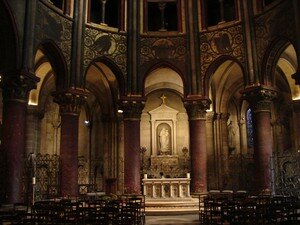 The
abbey remained insulated a long time on the southernmost slope from
small Pre with the Clerks; the high walls raised around the convent in
1239 per Simon, abbot of Saint-Germain, became into 1368
fortifications by order of Charles V, who, in war with the English,
feared a surprise of their share against the suburbs of Paris; at the
same time a small broad channel from eight to eleven measuring
apparatuses and deep of five measuring apparatuses was dug, which put
the ditches of the abbey in communication with the Seine. This channel,
called the small Seine or the Valley, and which separated the small Pre
one with the Clerks from large, filled about the middle of XVIth
century, became then the file of Small-Augustins, then the street
Bonaparte.
The
abbey remained insulated a long time on the southernmost slope from
small Pre with the Clerks; the high walls raised around the convent in
1239 per Simon, abbot of Saint-Germain, became into 1368
fortifications by order of Charles V, who, in war with the English,
feared a surprise of their share against the suburbs of Paris; at the
same time a small broad channel from eight to eleven measuring
apparatuses and deep of five measuring apparatuses was dug, which put
the ditches of the abbey in communication with the Seine. This channel,
called the small Seine or the Valley, and which separated the small Pre
one with the Clerks from large, filled about the middle of XVIth
century, became then the file of Small-Augustins, then the street
Bonaparte.
A small agglomeration was formed around the abbey
of Saint-Germain-des-Prés, located as its name indicates it outside
the agglomeration to the Middle Ages, it is it which will form the
German Holy District of the meadows. Later it yields part of its
grounds at the edge of the Seine (Pre-with-Clerks) to the University of
Paris.
During all Middle Ages, the abbey was very rich and
very powerful. The monastery becomes, with the centuries, one of the
great European intellectual centers.
 During The ancient Régime (XVI - XVIIIth centuries), the Abbey changes, it adopts
the rule of the Benedictines Saint of Maur in 1631 and profits from a
intellectual revival. New buildings are built.
During The ancient Régime (XVI - XVIIIth centuries), the Abbey changes, it adopts
the rule of the Benedictines Saint of Maur in 1631 and profits from a
intellectual revival. New buildings are built.
The abbey is
dissolved at the time of the French revolution and, in 1791, the church
becomes initially a parish church then is converted into salpetre
factory. The old tombs of the merovingians kings are dispersed, the
statues of the gate are destroyed and the library disepear in a fire
in 1794. The buildings and appendices of the Abbey are finally sold.
The grounds are parcelled out by residential buildings.
The buildings are devastated by the boring of the street of the Abbey in 1800.
 In
1803, the church is returned to the worship and during years which
follow, she then threatens to fall in ruins so much so that one plans
to demolish it. The two turns on the level of the bedside are
destroyed. From 1819 to 1823, the nave of the church is condemned for
reason of safety. Thanks to the active safeguard campaign carried out
by Victor Hugo and the priest of the parish, the church and the abbey
palate, street of the Abbey, are restored at the XIXth century by the
Goddle architect whereas the painter Hyppolite Flandrin covers the nave
of mural compositions.
In
1803, the church is returned to the worship and during years which
follow, she then threatens to fall in ruins so much so that one plans
to demolish it. The two turns on the level of the bedside are
destroyed. From 1819 to 1823, the nave of the church is condemned for
reason of safety. Thanks to the active safeguard campaign carried out
by Victor Hugo and the priest of the parish, the church and the abbey
palate, street of the Abbey, are restored at the XIXth century by the
Goddle architect whereas the painter Hyppolite Flandrin covers the nave
of mural compositions.
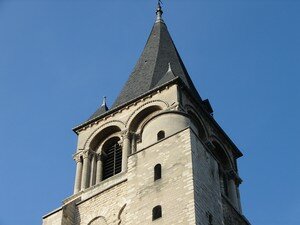 Outside,
the old church is announced by a petty porch, built at the XVIIth
century and surmounted by a gross square tower; on its higher floor,
two curved bays of XIIth century, accompanied by columns, open on each
one of its four faces and let escape the vibrations from its sound
bells; finished by a high arrow covered out of slates, the tower of
Saint-Germain of the Meadows, with his Romance arches, majestueusement
dominates this area of Paris, which was born and developed under its
shade. A curious memory is attached to it: on November 2, 1589, Henri
IV, besieging Paris, went up at the top of the tower, accompanied by
only one monk, to examine the situation of the city; he made then the
turn of the cloister without entering the church, and withdrew himself
without saying a word.
Outside,
the old church is announced by a petty porch, built at the XVIIth
century and surmounted by a gross square tower; on its higher floor,
two curved bays of XIIth century, accompanied by columns, open on each
one of its four faces and let escape the vibrations from its sound
bells; finished by a high arrow covered out of slates, the tower of
Saint-Germain of the Meadows, with his Romance arches, majestueusement
dominates this area of Paris, which was born and developed under its
shade. A curious memory is attached to it: on November 2, 1589, Henri
IV, besieging Paris, went up at the top of the tower, accompanied by
only one monk, to examine the situation of the city; he made then the
turn of the cloister without entering the church, and withdrew himself
without saying a word.
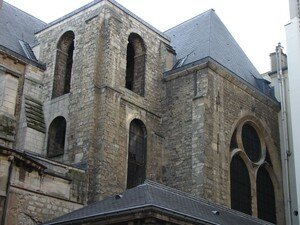 The
building incorporates elements of very different times. The ribbed
vault of the nave dates from XVIIth century, the presbytery of XVIIIth
and most of the interior decoration of XIXth century. Lastly, a charming public garden, contiguous to the church, shelters the ruins of the
Vault of the Virgin.
The
building incorporates elements of very different times. The ribbed
vault of the nave dates from XVIIth century, the presbytery of XVIIIth
and most of the interior decoration of XIXth century. Lastly, a charming public garden, contiguous to the church, shelters the ruins of the
Vault of the Virgin.
With its 65 meters length, 21 meters of
width, 19 meters height, the church is small sized. If Roman abbey
architecture changed his aspect since XIth century, with the liking
of the destruction and the multiple restorations, there remains
nevertheless a great number of elements of origin.
 The
capitals of the chorus with four spans present traditional topics
characteristic of the Roman style. Of the three bell-towers of
origin, the massive tower of frontage remains today, known as the
bell-tower-porch (built between 990 and 1014) which is one of the
oldest towers of France. It is in XIIth century that one will give to
this tower his arcades and his arrow, restored at last century. The
principal frontage dates from XIIth century, and one still
distinguishes the stocks of the two primitive side towers.
The
capitals of the chorus with four spans present traditional topics
characteristic of the Roman style. Of the three bell-towers of
origin, the massive tower of frontage remains today, known as the
bell-tower-porch (built between 990 and 1014) which is one of the
oldest towers of France. It is in XIIth century that one will give to
this tower his arcades and his arrow, restored at last century. The
principal frontage dates from XIIth century, and one still
distinguishes the stocks of the two primitive side towers.
The déambulatoire preserves also about intact its Romanesque architecture of XIIth century. It is bordered by five radiating chapels, arched warheads and devoted in 1163 by the pope Alexandre III. The stained glasses of the fourth vault are the only ones with being composed of fragments the glass ones of XIIIth century.
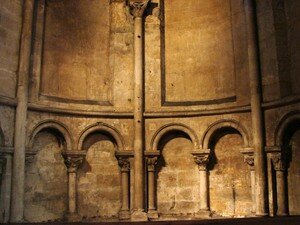 The
arcades, built about 1163 on the model of Senlis, Saint-Denis and
Boundary-line (of which a part is still in semicircular arch), formerly
supported platforms (as in Notre-Dame), removed in 1646. The marble
barrels are much older and come from the primitive building of
Childebert. They constitute the most beautiful merovingians vestiges capital. The chorus presents admirable columns of the triforium. They
come from the very first merovingian basilica built in VIth century.
The
arcades, built about 1163 on the model of Senlis, Saint-Denis and
Boundary-line (of which a part is still in semicircular arch), formerly
supported platforms (as in Notre-Dame), removed in 1646. The marble
barrels are much older and come from the primitive building of
Childebert. They constitute the most beautiful merovingians vestiges capital. The chorus presents admirable columns of the triforium. They
come from the very first merovingian basilica built in VIth century.
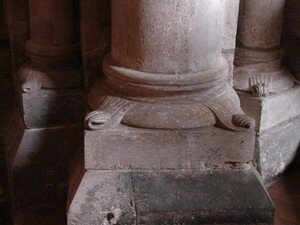 During
its last restoration, the whole church, from the vault to the walls,
was painted in various colors, under the direction of the Baltard
architect; this polychrome decoration applies even to the columns,
whose capitals are gilded.
During
its last restoration, the whole church, from the vault to the walls,
was painted in various colors, under the direction of the Baltard
architect; this polychrome decoration applies even to the columns,
whose capitals are gilded.
http://www.paris-pittoresque.com/monuments/40b.htm
http://www.insecula.com/salle/MS01891.html
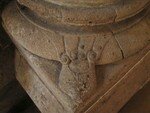 A few column bases represent surely indications when with the earth currents present under the church.
A few column bases represent surely indications when with the earth currents present under the church.
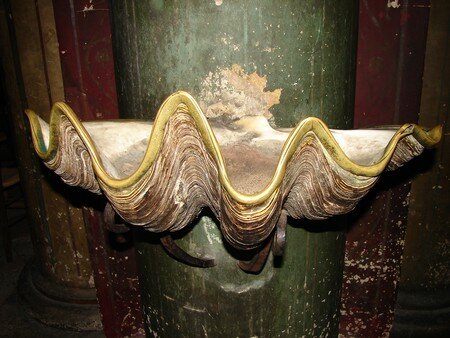 A beautiful stoup accomodates us on the left while entering. It is a large shell, the tridacne.
A beautiful stoup accomodates us on the left while entering. It is a large shell, the tridacne.
Larger mollusc of the world after the giant squid, the giant stoup or tridacne belongs to the sad list of the animals in the process of disappearance. Fished in an excessive way for the interest of its shell and because it is edible, the tridacne is today in danger and is the subject of an international protection.
This enormous shell whose valves are well-known at the entry of the
churches and the cathedrals, can reach dimensions enough surprising.
The known record borders 1,40 m for close to 250kg.
This
animal enjoys a bad reputation: the legend says that it could grab the
arm or the leg of a plunger and more to release them… A simple
observation of the biology of this animal shows that it is completely
unable to hurt whoever.
 With that two reasons:
With that two reasons:
the
first comes owing to the fact that our giant cannot be
closed again on a possible prey without being wounded itself by
gripping the flesh of his coat which overflows of the shell, this
movement asking him for several minutes.
The second reason comes
owing to the fact that the tridacne is vegetarian. This mode
vegetarian which reassures us on the intentions of the animal, is
rather not very common. Indeed, to get its food, it shelters and
“cultivates” in its living tissue, of the microscopic green algas of
which it is nourished. To develop, these algae need light, which
explains why the stoup lives in not very deep water of the coral reefs
of Pacifique south-west.
As all the other species of stoups (there
are 6), the giant tridacne lives among the corals of the reefs,
inserted vertically, the opening of the shell directed upwards.
When
it is young, the animal secretes a byssus, tuft of filaments which
passes by the opening of the shell and which it is fixed at sea-bed,
the hinge directed downwards. As the colony grows, with the corals,
sponges, the algae covers it or surround it, dissimulating it under
their mass, while letting exceed only the edge. The slightly isolated
valves let foresee the coat brilliantly coloured in green, red, or
blue. The edges of this coat are roughcast of protuberance locking up
the hyaline bodies, kinds of lenses which concentrate the light in the
depths of fabrics and support there by photosynthesis, the
multiplication of microscopic algae. It is much beautiful in the water, isn't it ?
 Some photographs of expressive capitals, old sculptures.
Some photographs of expressive capitals, old sculptures.

/https%3A%2F%2Fprofilepics.canalblog.com%2Fprofilepics%2F1%2F1%2F116167.jpg)
/https%3A%2F%2Fstorage.canalblog.com%2F49%2F16%2F312499%2F14620054_o.jpg)
/https%3A%2F%2Fstorage.canalblog.com%2F53%2F18%2F312499%2F14151229_o.jpg)
/https%3A%2F%2Fstorage.canalblog.com%2F07%2F05%2F312499%2F14149867_o.jpg)
/https%3A%2F%2Fstorage.canalblog.com%2F11%2F35%2F312499%2F14149307_o.jpg)
/https%3A%2F%2Fstorage.canalblog.com%2F90%2F14%2F312499%2F14125247_o.jpg)


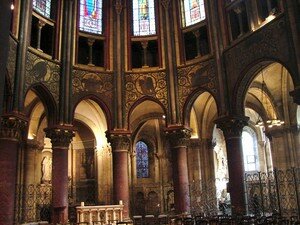





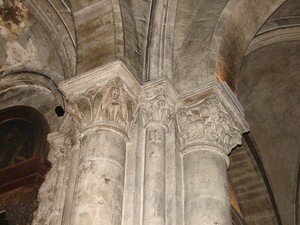
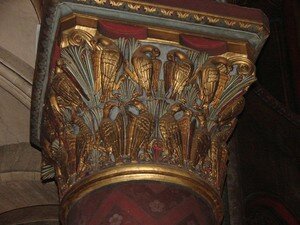
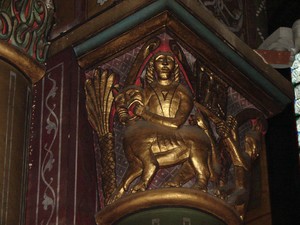



/https%3A%2F%2Fstorage.canalblog.com%2F12%2F98%2F137895%2F6624411_p.jpg)
/https%3A%2F%2Fstorage.canalblog.com%2F34%2F82%2F137895%2F27207854_p.jpg)
/https%3A%2F%2Fstorage.canalblog.com%2F32%2F37%2F137895%2F15872299_p.jpg)
/https%3A%2F%2Fstorage.canalblog.com%2F37%2F81%2F137895%2F15879822_p.jpg)